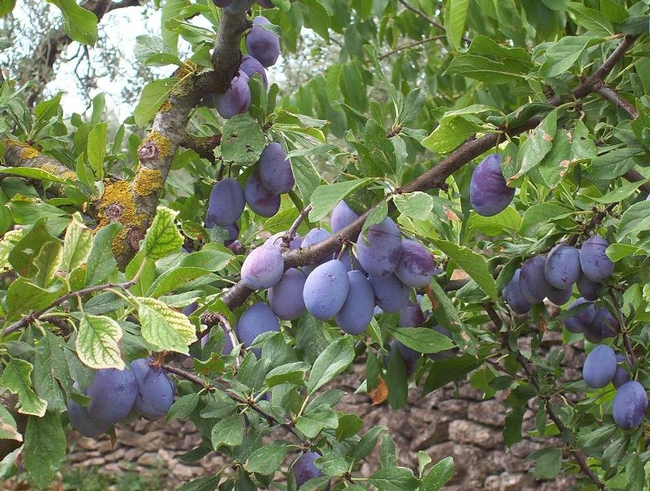By Donna Woodward, UC Master Gardener of Napa County
When is a plum a prune? Short answer: When it's dried. That's what the dictionary says, but common terminology is not always so straightforward.
A few years ago, I planted a plum cultivar called Improved French Prune. The fruit is delicious fresh, but is it a prune then?
In researching the subject, I learned that this particular cultivar is the standard for prune production in California. Before Napa Valley became famous for grapes, prunes and walnuts were major crops. Napa old-timers still speak of “prune” orchards. My reading also turned up a reference to an Italian prune plum. The term “prune” is just a descriptor, describing a variety suitable for drying. When fresh, they're all plums.
Over 250 varieties of plums are grown in California. All cultivated plums are derived from two basic types: European (Prunus domestica) and Japanese (Prunus salicina). The Japanese plum originated in China and was introduced to the U.S. via Japan in the 1800s. Both types grow well in the western U.S. Both bloom in early spring and provide fruit between May and September, with the Japanese generally producing earlier than the European. All plums are high in nutritional value, providing fiber, vitamins C, A, K and potassium and other minerals.
Most prunes are produced from European plum varieties. These are generally oval and freestone while the Japanese tend to be round and clingstone. European trees are more likely to be self-pollinating and require less care, but these are generalizations and there are many variables.
Supermarket plums, sweet and juicy, are mostly Japanese varieties. One of the most common is the Santa Rosa plum, developed by Luther Burbank and considered one of his most successful creations. It doesn't ship well so has fallen out of favor commercially. We are lucky to live where it was developed and is still widely cultivated.
I prefer the European varieties for fresh eating as well as for preserving. My Improved French tree produces lavishly. The flesh is firm and not mushy or overly sweet. The skin provides just the right amount of chewiness to complement the sweet-tart flesh. The tree requires little in the way of care and is self-pollinating. Some similar varieties are Stanley, Italian and Valor.
The Damson, an old European variety, is uncommon. The fruit is small, with a large pit. A clingstone variety, it is considered too sour to eat fresh but is said to make the best jams and jellies. The European Mirabelle plum is another delicacy. It is very sweet and famously used for eau de vie. Importation of the fruit is strictly regulated. In the Lorraine region of eastern France, where it is grown, it has PDO, or protected designation of origin, status. It is possible to grow the Mirabelle plum in Napa Valley.
Also among the European varieties are a number of greengage cultivars. Their skin ranges in color from green to yellowish, with a pale blue blush in some. Greengage plums are known for their rich flavor and are considered to be among the finest dessert plums.
California produces 90 percent of all plums grown in the United States. Among the Japanese varieties grown for fresh eating there are many delicious choices. Skin color ranges from yellow to red, orange, purple, mahogany and black. The Beauty plum has red-over-yellow skin and amber flesh streaked with red. The Burgundy is maroon with pale yellow flesh. The Elephant Heart has dark reddish-purple fruit and sweet, juicy red flesh. Another longtime favorite is the Satsuma, which has mottled maroon-over-green skin and dark red flesh. The Wickson is a large heart-shaped greenish-yellow fruit with translucent flesh.
You may have noticed a frosty look on the skin of some plums. Known as bloom, this silver-white dusting, also found on grapes and blueberries, acts as a barrier against insects and bacteria and helps seal in the fruit's moisture. Bloom is a sign of freshness; it fades with time and handling.
The fresh-plum season runs from June through September. If you intend to plant new plum trees, taste as many varieties as you can and then pick your favorites. Plums are best planted as bare-root trees in December or January. Take note of which varieties are self-fruiting and which require pollinizers; also inquire about which pollinizers are required for a particular variety. Do a little research to find the plum that works best for your environment and satisfies your taste.
The UC Master Gardeners of Napa County are volunteers who provide UC research-based information on home gardening and answer your questions. To find out more about upcoming programs or to ask a garden question, visit the Master Gardener website (http://napamg.ucanr.edu) or call (707) 253-4221 between 9 a.m. and 12 noon on Mondays, Wednesdays or Fridays.
Attached Images:
